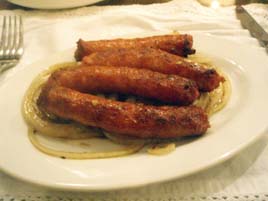Dropping In: Má Pêche
 Monday, June 14, 2010 at 03:47PM
Monday, June 14, 2010 at 03:47PM  The Momofuku phenomenon has largely passed me by. Mind you, I like David Chang’s restaurants, having visited them seven times, in all. But I never bought into the unstinting bouquets of rapture that floated his way, from people whom I believed knew better.
The Momofuku phenomenon has largely passed me by. Mind you, I like David Chang’s restaurants, having visited them seven times, in all. But I never bought into the unstinting bouquets of rapture that floated his way, from people whom I believed knew better.
That said, I’d love to have been able to drop in on the East Village Momofukus more often, during the era when Chang’s adoring faithful were teary-eyed over the latest new dish his chefs had created, on practically a daily basis. I’m sure many of those dishes were very good indeed, but that part of town was too far away for me to visit with any regularity—especially given Chang’s no-reservations policy, which meant one was not even assured of getting a seat.
The Momofukologists say that the East Village places have lost a step (though they remain packed at prime times). Chang himself is now tending a much larger empire. Tien Ho, the day-to-day chef at Ssäm Bar during its heyday, is now at Má Pêche. As I mentioned after my first visit, I find the cuisine at Má Pêche far too timid, but I assume Ho hasn’t forgotten how to cook. As it is on my commuting path, I’m willing to give it a few more shots. I keep hoping to see the inspiration that made Momofuku what it was. I haven’t found it yet.
Má Pêche is a Momofuku you can get into. My experience, and everyone else’s, is that the place is never full, or even close. Just a day after telling the Times that his no-resy free-for all is more “democratic,” Chang started taking them on the web, though only for lunch and prix fixe dinner from 5–7 p.m. I suspect that more will follow. Midtown diners tend to want reservations, and if the restaurant is empty, you might as well give customers what they want.
When I arrived last Friday evening, at around 6:05 p.m., the host said, “I can seat you at the bar or the raw bar.” I thought, perhaps they’re finally busy. I came down the stairs to find a dining room two-thirds empty. They couldn’t possibly have believed that all those seats would miraculously fill up—which, of course, they did not. So why offer me only a backless bar stool, when the long communal table was available.
One can speculate endlessly the reasons they might have had for putting me all alone, at a corner of the raw bar. Charitably, they might have believed a solo diner preferred the bar, but in that case I’d suggest they ask. A friend allowed that perhaps they thought it would look silly to have a solo diner alone at that long, X-shaped table. Perhaps, but they ought to be thinking of what the customer wants, especially when they have vast real estate that clearly is not filling up. Let’s just say they need to get a lot smarter.


Onto the food. I started with the pork ribs (left), which came out almost instantly. I take no issue with their being obviously pre-made, but they were slightly dried out. Pork spring rolls (right) were fresh as a daisy, as if the vegetables had been picked that day. I had a glass of wine, which was one of the stingiest pours I have seen—probably around three ounces.
Má Pêche remains a promising restaurant that needs a lot of work.
















